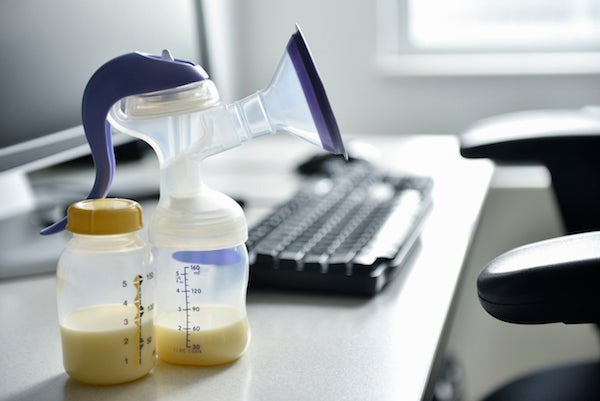This article was published in Scientific American’s former blog network and reflects the views of the author, not necessarily those of Scientific American
Biology tasks women as the creators and guardians of life in its early and most vulnerable stages. Pregnancy, giving birth, healing from it physically and emotionally, breast-feeding, parent–child bonding, child care and everything that accompanies them are a normal part of life, much of it necessary for our existence as a species. And yet this is not all that defines us. Unfortunately, depending on the society one lives in, having a baby can serve as an impediment to other life pursuits.
I am a scientist, a professor, and a science communicator. I am also an adoring mother of two amazing children. To support my career endeavors, I attend and present at many conferences. After having my children and experiencing the need to regularly pump and store breast milk when away from them, I developed a fascination with assessing the quality of lactation rooms. You can learn a lot about the organization hosting the conference from the state of their lactation room. For example, a clean, private, comfortable space dedicated for attendees who are breastfeeding or pumping breast milk says, “We value parents and support the biological needs of those nursing”. No such dedicated space, or perhaps a meager excuse for one, says the opposite.
I never used to notice these things. Of course, I was keenly aware of various other challenges women faced in the workplace, having both seen and experienced sexual harassment and gender bias on many occasions. I was also aware of the gut-wrenching statistics that revealed how having a baby negatively impacts career advancement for women. In an attempt to combat and overcome such things, I took a proactive approach: I attended women-in-science meetings and workshops, served on multiple committees to address women-in-science issues and participated in various outreach programs to support girls in science.
On supporting science journalism
If you're enjoying this article, consider supporting our award-winning journalism by subscribing. By purchasing a subscription you are helping to ensure the future of impactful stories about the discoveries and ideas shaping our world today.
As a Mexican-American, I was particularly sensitive to the additional injustices experienced by women from underrepresented and underserved groups. Because of my fair skin, and the white privilege that goes along with it, I had witnessed many racist conversations and decisions by those who weren’t aware I was an “other.”

Credit: Jamie Grill Getty Images
But I didn’t really understand how unjust the academic system was for career advancement for women until I had children.
From the moment we enter the beginning stages of starting a family, many of us are forced to do battle with various health issues, including nausea, nerve and lower back pain, dehydration, anemia and flat-out exhaustion. In the U.S., however, we are met with little to no prepartum assistance in the workplace. The time afforded to us for maternity leave, paid or unpaid, is hugely insufficient, and the severe lack of postpartum medical care for mothers in our country is unconscionable. Despite a mountain of research findings emphasizing the importance of maternal physical and mental health for both mother and child, our policies to support women during this time—or lack thereof—are illogical and shortsighted.
Concerning my own experiences, I could talk about how the only medical care I received postpartum involved a quick physical checkup, followed by a mental health questionnaire that alerted my doctor to my level of “baby blues.” But this only led to recommendations like, “try to get some more sleep,” “don’t forget to drink lots of water” and “maybe try talking to a therapist?”
I could talk about how I would have to bite down on a hand towel when I was breast-feeding through cracked, bloody nipples, because no doctor or lactation consultant could figure out how to remedy the situation. I could talk about how this eventually caused me to give up breast-feeding much earlier than I had wanted, resulting in deep feelings of loss, guilt and depression—feelings made worse by the pitchfork-carrying “breast-is-best” mob that descends on you with their shaming blanket of self-righteous judgment when you reveal a bottle of formula.
I could talk about how a painful miscarriage and, later, a botched C-section led to post-traumatic stress that went undiagnosed and untreated at the time. This snowballed into a severe anxiety disorder, one that in my darkest moment made me question if my family would be better off without me.

For illustration only; this is not the author. Credit: Jamie Grill Getty Images
I could tell you about how women who deign to pursue a career and have a family are often sentenced to the expectations that we must work as if family did not exist—and parent as if work did not exist. It’s the Schrödinger’s cat of being a working mother, which is not only unfair but also destructive on a personal, professional and societal level.
My children are still young, so many of these wounds are still fresh. They lay open, invisible, on my shoulders as I go through my day, lead my research program, teach my students and attempt to be the best partner, mother and community member that I can be. Sometimes during faculty meetings I look around the table at my colleagues and wonder what sorts of internal battles they might be fighting. It makes me feel less alone. Yet my wounds are not unique to me, and neither is my story. I represent the experiences of many working mothers.
Being a woman, a scientist and now a mother in a system created for and by white men with stay-at-home partners obviously has its problems. Many of us are either pushed out or decide to set sail for smoother waters. Sometimes when I hear exclamations of “we need to inspire more women to pursue the sciences!” I think: We’re here! We want to do science! But how can we when, to advance, we’re forced to run at double the speed of our male colleagues on a career track clouded by bias and covered in LEGOs?
Sometimes people ask me why I bother to stay in a career so hostile to women. I remind them the culture is changing, more quickly in some places than others. I also remind them it is not just science or academia in general that harbors this sex-biased hostility. My friends in law, business and entertainment have horrified me with unjust tales from their workplaces. And yet many of us stay the course, determined to both overcome and overturn obstacles in our paths to pursue our goals and passions. We do so by standing on the shoulders of fierce women who came before us, our forward momentum toward a destination made visible by their efforts, a hand hopefully extended behind us to pull up those even less privileged.

For illustration only. Credit: Thanasis Zovoilis Getty Images
A few months ago I traveled across the country to attend a scientific conference. For me, if science were a town, conferences would be the town square. Thousands of people from all over the world convened at this particular conference to present their work, learn of the latest research findings and technologies, develop new ideas and collaborations, find inspiration, meet with granting agencies, recruit trainees, find jobs and in general be part of a greater community. I had always loved attending conferences for these reasons.
Unfortunately, in the past few years that had become more difficult for me due to pregnancy, breast-feeding, and child care issues and responsibilities. But now, at this particular meeting, pregnancies and breast-feeding were behind me. I was a faculty member at an institution I loved, making a decent salary. My husband, also a new professor, was caring for our children back at home in collaboration with responsible day care providers we could finally afford. I leaned against a wall inside the conference center, warmed by sunlight streaming in from a nearby window. I took a deep breath, slowly sipped my hot tea and scrolled hungrily through the scientific program. I had survived. I was back.
In between lectures and poster presentations, I wondered around the conference hall in search of their lactation room. Though I no longer needed it, I was still curious to see if it had improved from the previous year. Last time, to reach the lactation room required an epic journey away from the main conference hall. Most nursing moms forewent the pilgrimage, instead ducking into nearby corners to feed their babies or pump milk in bathrooms so as to make it to their presentations in time. Pumping milk in a bathroom is a nasty affair, one that I’ve written about. Would you want your meal made in a bathroom?
As I continued my search, I was happy to see child care was available on location, which is undeniably an incredibly helpful resource for attendees with children in tow. Be that as it may, those arguably in the most sensitive period of their career stage—namely graduate students, postdocs and new faculty—are usually the ones in need of these services the most and yet cannot afford them. When I was a postdoc, I couldn’t even afford to buy an extra plane ticket for my child to fly to a conference with me, let alone pay for child care once I got there.
I found the lactation room close to the main exhibit hall, a vast improvement compared with the previous year. I quietly opened the door, not wanting to disturb any mothers inside. To my surprise, the large, primely located room was empty. Taking a closer look, I understood why. Inside, I found three pop-up curtains. Within them was a standard conference chair, a changing table and a handful of extension cords strewn about. At a conference with one of the highest registration fees in my field, attended by tens of thousands of people, with hundreds of presentations on the science of maternal health, this is all the organization provided to support the lactation needs of their participants?
With clenched fists and flared nostrils, I closed my eyes and took deep breaths to calm down. Perhaps getting so upset about a lactation room at a conference might seem silly to some. But for me, these meager accommodations represented a much bigger problem about how women are treated in this country. They represented all the physical and mental pain and suffering I had gone through after having my children while trying to succeed in what was already an extremely competitive environment.
I felt a maternal protectiveness for my sisters in science trying to stay afloat in a sea of inequity. At that moment, pushing fears aside of career retribution, I publically called out the society hosting the conference and demanded better. I used social media as my megaphone, posting pictures of the paltry offerings for all to see. Other mothers, parents and allies responded, posting their own pictures, grievances and demands for change.
I met with a representative from the conference’s onsite headquarters to suggest how they could improve. For example, I recommended that the organizers consult with someone who had actually lactated at a conference, perhaps even a professional lactation consultant, when coordinating appropriate resources. For the time being, I recommended a few quick and easy ways to make nursing mothers more comfortable.

For illustration only. Credit: Sam Edwards Getty Images
Within the hour the power cords had been wrangled and tamed, large sofa chairs had replaced their small, standard conference counterparts, and an additional lounge was created outside the curtains, equipped with tables. Later that day I walked in to have a look. The lights were dimmed a bit, providing a more soothing environment. Multiple women were in the room now, seemingly at ease on the sofas, either pumping or nursing. It was quiet and peaceful, with only the faint whoosh-whoosh sound coming from breast milk pumps. I smiled, feeling a small sense of therapeutic relief and accomplishment. A woman, donning a blue checked nursing cover, caught my gaze and smiled back.
That’s when it occurred to me. The conference organizers wanted to support the needs of their nursing attendees—or at minimum avoid negative attention. They just didn’t know how. I got to work on listing all of the ways conferences could make their events more family-friendly, especially for working mothers, and why this benefits everyone.
Realizing my suggestions were born out of my own experiences and viewpoints, I called upon the power of diversity to help solve this childcare-conference conundrum. I organized a working group of 45 fellow mothers-in-science, composed of postdocs, assistant and tenured professors, scientists working in industry, National Academy of Science members, science journal editors, and an MD. In addition, approximately a forth of us were members of underrepresented groups in science in the U.S.. I uploaded my manuscript draft to a shared cloud drive and witnessed edits, suggestions, and revisions pour in from my co-authors in real time.
After weeks of weathering an incredibly supportive, inspiring, and productive whirlwind of activity, we easily reached a consensus on the final piece. In it, we had detailed a multitude of ways in which conferences, big and small, financially robust and challenged, could support parent, especially mother, attendees. We submitted our article to a top science journal with hopes of reaching a broad readership. This journal even had a section specific to addressing topics intersecting science and society with the potential to influence policy. We received a canned rejection notice that stated our article wasn’t a “great fit” for their section.
Surprised, but undeterred, we submitted to the next journal. And the next and the next. In the past, journals have published numerous articles pregnant with depressing statistics revealing the disadvantages working mothers face as compared to their childless or male counterparts. But now that 46 women scientists had come together to help solve one of these problems, our article fell on deaf ears.
We deflected rejections off our thick suits of armor wrought from grit and perseverance. To add insult to injury, it did not go unnoticed that the editors – the gatekeepers – of these top journals serving us our rejections were men. Could their lack of deep personal experience with the subject matter have influenced their assessment of our piece? As scientists we know that correlation does not equal causation, but it does inspire hypotheses. In this case, it inspires the need for greater representation of women in top editorial positions in order to bring more perspectives and solutions to the discourse.
When our piece was finally met with acceptance, it was conditional. Some editors wanted personal sob stories of our struggles infused throughout. Others wanted us to shorten it by more than half its length, which would mean losing many of our recommendations. I also received comments of whataboutery, “What about men?.. What about dads?.. Why aren’t you including them as authors and discussion of their issues in the piece?.. They contribute too!..” Indeed they (or partners in general) do, my husband more than most, but I know he would be the first to agree with me when I say, When men are able to go through the throes of pregnancy, have their bodies ripped open during birth, continuously and exhaustingly create resources from their own bodies to feed their child, and on top of that be paid and valued less for often doing more than their female counterparts, then I promise to include the issues men face in our next article. Until then, a true male ally is one who will help us to create and protect space to address our struggles right now.
In the end, our piece was published in the Proceedings of the National Academy of Science, facilitated by a very supportive (male) editor. I felt a sense of relief the moment it went online, not only because of the changes I wanted to see implemented at conferences, but because I didn’t want others to feel the pain and loneliness that I had suffered. I wanted mothers and those considering starting a family to know that forty-six of us were willing to speak up for them and demand change. This piece was more than a recommendations guide for conference organizers; it was a blueprint for how to support an equitable environment by normalizing our needs as parents in academia and beyond.
I am a mother. I am a scientist. I am a survivor of postpartum depression. I am determined to help close the gender gap and make things better for my sisters who come after me. Today I took on conferences. Tomorrow, what will you take on?